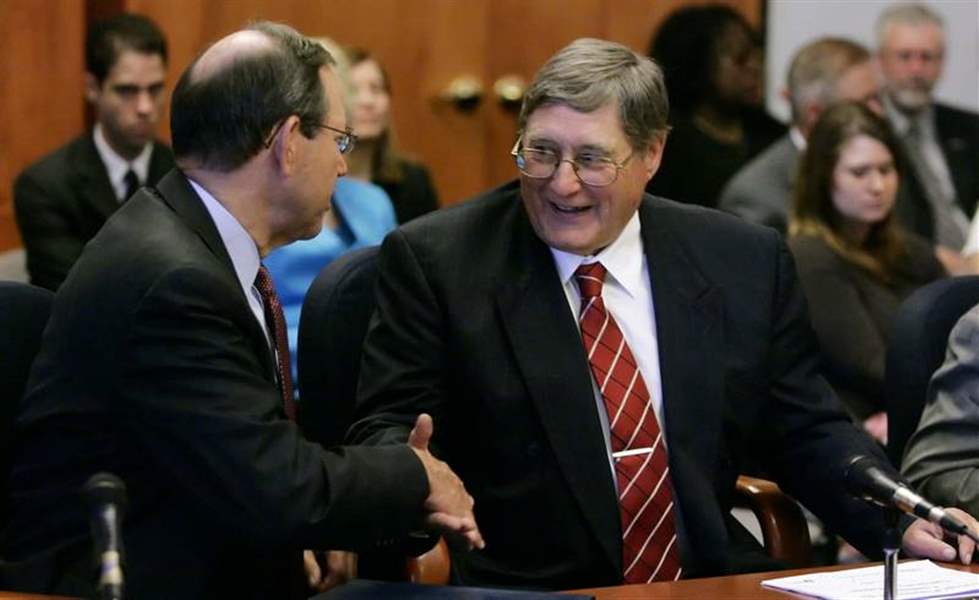
New leader offers vision for reshaped institution
7/7/2006
Gov. Bob Taft, left, and UT President Lloyd Jacobs attended the first trustees meeting of the newly merged university.

Gov. Bob Taft, left, and UT President Lloyd Jacobs attended the first trustees meeting of the newly merged university.
The University of Toledo will keep its college of law on campus and become more student-centered to increase enrollment, the president of the newly merged institution announced yesterday.
Dr. Lloyd Jacobs, who was president of Medical University of Ohio before its merger on Saturday with UT and now leads the combined school, discussed his strategic plan during the institution's first board of trustees meeting.
Among Dr. Jacobs' first directives for the combined university: ending any discussion of moving the law school from the main campus to a downtown location closer to law offices and Toledo, Lucas County, and federal courthouses.
He also plans to create a commission on what he called "student-centeredness" and wants to identify more "synergies" between the former UT and MUO to build upon.

Hospital operating room employees were treated to hot dogs during a celebration picnic at the Health Science Campus.
Dr. Jacobs said the combined UT will help to create a vibrant economy in northwest Ohio. He also said UT students will get "better service, more educational value for your dollar, [and] a great place to live."
Ohio Gov. Bob Taft, who attended the trustees' meeting, praised the merger.
"You have taken bold steps to bring about the merger, and it will require even more bold steps to fully realize its benefits for the students you serve," the governor said.
Trustee Richard Stansley, who was elected chairman of the merged institution's board of trustees, said enrollment at both schools will increase as a result of the merger.
Dr. Jacobs also said the university should grow in both size and stature, but he issued a caveat. "It is my belief that [for] institutions such as ours, that their greatest danger is the tendency to spread themselves too thin wanting to be all things to all people - not being able to say no," Dr. Jacobs said. "I believe accomplishing the dream of which we speak here this morning depends heavily on our ability to focus."
Mr. Taft said he was very impressed with Dr. Jacobs' plans, especially that they appeared to be focused on students.
The governor told the trustees that colleges and universities need to increase enrollment, but he admitted that they are challenged by decreasing funding from the state and other sources.
"On the one hand, we want to expand enrollment. On the other hand, it's a constrained financial environment," Mr. Taft said in a press conference afterwards. "That means that our universities are going to have to manage more skillfully, and that is one of the great opportunities of this merger."
Mr. Taft told the trustees and the media afterward that the merger should create "significant long-term savings."
UT expects to help save costs by eliminating some jobs; it said it will identify those positions by September. The departments of facilities, finance, human resources, and information technology are areas targeted for possible cuts.
The merged university has budgeted $2 million to $5 million for severance and early retirement payments. But implementing the merger could cost at least $30 million, according to the most recent UT estimates.
A 2005 analysis of the merger by Ryan Beck & Co., an investment bank, concluded that the Ohio General Assembly "will provide funding to support the change with the understanding that it will save the state money in the long run."
However, state Sen. Randy Gardner (R., Bowling Green) said last month: "I don't think there's any expectation that the state of Ohio would provide 100 percent of the funding for the $30 million cost." Neither Mr. Taft nor Dr. Jacobs addressed the $30 million cost yesterday.
Mr. Taft did tell the trustees that UT should continue to work with other universities to create academic alliances and ways to conserve on overhead costs through consolidation.
"I challenge you to go even further and really look to work with others in this region, to build a regional strategy that provides the best options for the students of northwest Ohio at the most affordable cost," Mr. Taft said.
The governor asked the trustees to support a more rigorous high school core curriculum, a key piece of his education reform agenda that he promised during his January state of the state address.
A "Celebration Picnic" to mark the UT merger was held yesterday afternoon near the Raymon Mulford Library on the former MUO campus, which is now officially called the UT Health Science Campus.
Faculty, staff, and students were treated to hot dogs, veggie burgers, pasta salad, chips, beverages, and cookies. Round-trip bus service was provided to transport partygoers from UT's main campus to the former MUO campus. Third-shift employees at both campuses were provided box lunches last night.
In an e-mail invitation to faculty and students, Dr. Jacobs said the picnic would give them a chance to "meet new people, stroll through the campus, enjoy some great food, and have a good relaxing time.
"The new university means many things to many people, including the opportunity to celebrate our commitment to excellence to each other, and to the community."
Contact Ignazio Messina at:
imessina@theblade.com
or 419-724-6171.